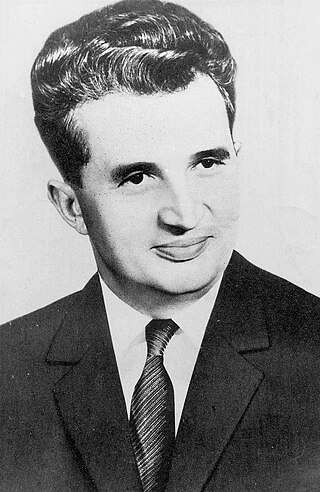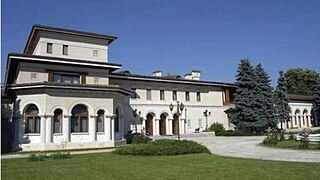
Nicolae Ceaușescu was a Romanian communist politician and statesman. He was the general secretary of the Romanian Communist Party from 1965 to 1989, and the second and last communist leader of Romania. He was also the country's head of state from 1967 to 1989, and widely classified as a dictator, serving as President of the State Council and from 1974 concurrently as President of the Republic, until his overthrow and execution in the Romanian Revolution in December 1989, part of a series of anti-communist uprisings in Eastern Europe that year.

The Socialist Republic of Romania was a Marxist–Leninist one-party socialist state that existed officially in Romania from 1947 to 1989. From 1947 to 1965, the state was known as the Romanian People's Republic. The country was an Eastern Bloc state and a member of the Warsaw Pact with a dominant role for the Romanian Communist Party enshrined in its constitutions. Geographically, RSR was bordered by the Black Sea to the east, the Soviet Union to the north and east, Hungary and Yugoslavia to the west, and Bulgaria to the south.

The Romanian revolution was a period of violent civil unrest in Romania during December 1989 as a part of the revolutions of 1989 that occurred in several countries around the world, primarily within the Eastern Bloc. The Romanian revolution started in the city of Timișoara and soon spread throughout the country, ultimately culminating in the drumhead trial and execution of longtime Romanian Communist Party (PCR) General Secretary Nicolae Ceaușescu and his wife Elena, and the end of 42 years of Communist rule in Romania. It was also the last removal of a Marxist–Leninist government in a Warsaw Pact country during the events of 1989, and the only one that violently overthrew a country's leadership and executed its leader; according to estimates, over one thousand people died and thousands more were injured.

The Sighet Prison, located in the city of Sighetu Marmației, Maramureș County, Romania, was used by Romania to hold criminals, prisoners of war, and political prisoners. It is now the site of the Sighet Memorial Museum, part of the Memorial of the Victims of Communism.
Nicolae Ceaușescu, who led Romania from 1965 to 1989, served as General Secretary of the Romanian Communist Party. Ceaușescu had a large family, several members of which wielded influence in Communist Romania. Below are given outlines of his immediate family members' lives, with links to those who have separate articles about them.
Revolution Square is a square in central Bucharest, on Calea Victoriei. Known as Palace Square until 1989, it was renamed after the Romanian Revolution of December 1989. The former Royal Palace, the Athenaeum, the Athénée Palace Hotel, the University of Bucharest Library and the Memorial of Rebirth are located here. The square also houses the building of the former Central Committee of the Romanian Communist Party. In 1990, the building became the seat of the Senate and since 2006 it houses the Ministry of Interior and Administrative Reform.

Gherla Prison is a penitentiary located in the Romanian city of Gherla, in Cluj County. The prison dates from 1785; it is infamous for the treatment of its political inmates, especially during the Communist regime. In Romanian slang the generic word for a prison is "gherlă", after the institution.

Nicolae Pleșiță was a Romanian intelligence official and secret police investigator. From 1980 to 1984, he led the Foreign Intelligence Service of the Securitate, the secret service of Communist Romania. He was described by the New York Times and Associated Press at the time of his death as "a die-hard Communist and ruthless chief of the Securitate secret police."

Snagov Palace is a former royal palace on the shore of Lake Snagov, about 40 km north-east of Bucharest, in Ilfov County, Romania. The palace is situated in the commune of Snagov and near the Snagov Monastery.

Ioan Totu was a Romanian economist and communist politician who served as the Vice Prime Minister of Romania from 1982 to 1985 and as Minister of Foreign Affairs from 1986 to 1989, during the rule of Nicolae Ceaușescu. He briefly served as President of the State Planning Committee in late 1989.

Aiud Prison is a prison complex in Aiud, Alba County, located in central Transylvania, Romania. It is infamous for the treatment of its political inmates, especially during World War II under the rule of Ion Antonescu, and later under the Communist regime.

Emil Bobu was a Romanian Communist activist and politician, who served as Interior Minister from 1973 to 1975 and as Labor Minister from 1979 to 1981. He was an influential figure in the later years of the Communist regime until his downfall during the 1989 Revolution.

Râmnicu Sărat Prison is a former prison located in Râmnicu Sărat, Buzău County, Romania. The building is listed as a historic monument by Romania's Ministry of Culture and Religious Affairs.

Jilava Prison is a prison located in Jilava, a village south of Bucharest, Romania.
The Caransebeș Prison was a prison in Caransebeș, Romania.
Botoșani Prison is a prison located in Botoșani, Romania.

Craiova Prison is a prison located in Craiova, Romania.
Brașov Prison was a prison located in Brașov, Romania.
Oradea Prison is a prison located in Oradea, Romania.
Galați Prison is a prison located in Galați, Romania.













